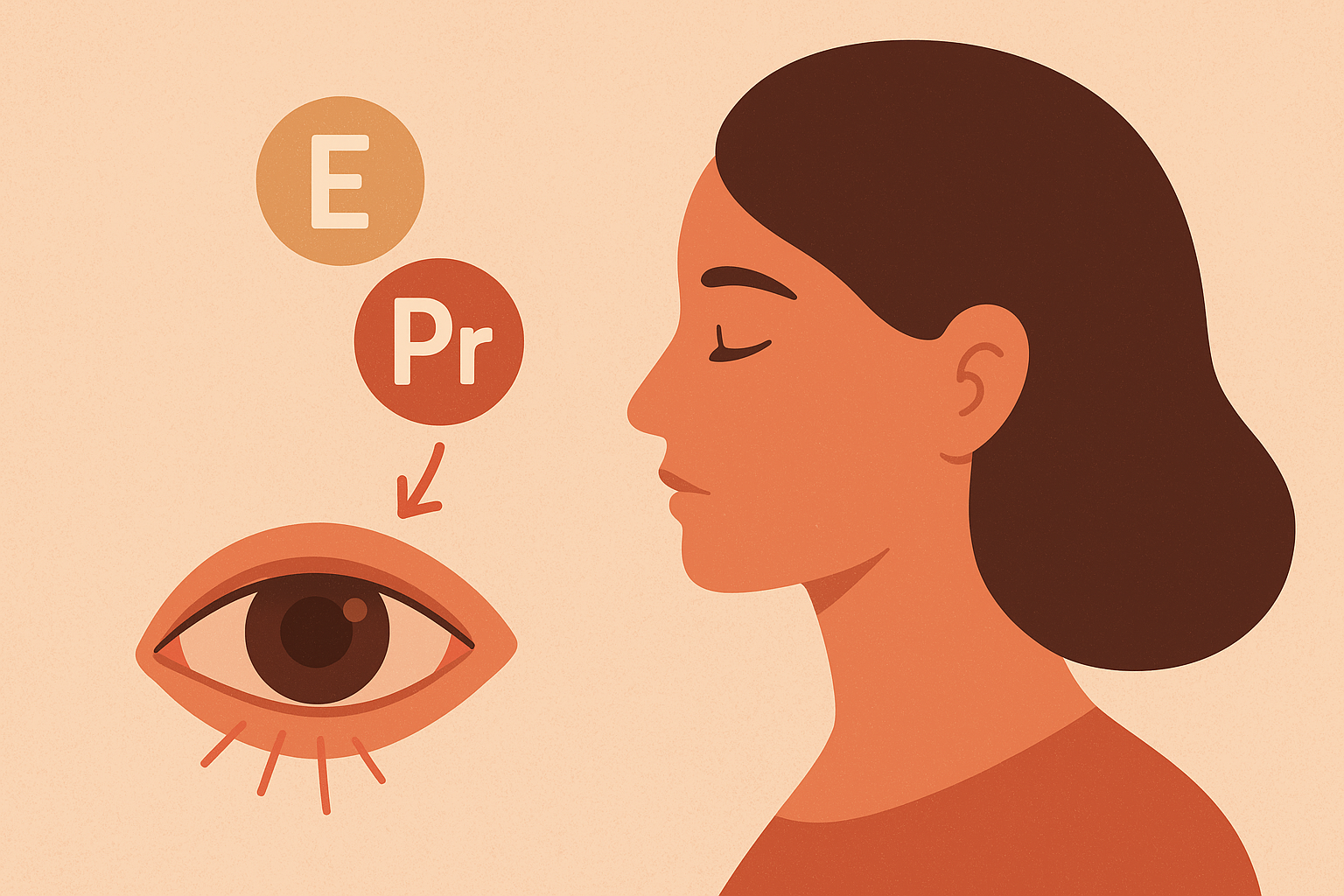Introduction: How Hormones Shape the Way We See
For too long, vision care has treated the eyes as an isolated system. Yet, research confirms that fluctuations in systemic hormones—primarily estrogen and progesterone—have a profound and often uncomfortable impact on ocular health. Understanding the link between hormonal changes and vision is essential.
Hormones influence almost every system in the human body — including your eyes. While most people associate hormonal changes with reproductive health or metabolism, very few realize that hormonal fluctuations throughout life directly affect tear production, corneal shape, eye pressure, refractive errors, inflammation, and retinal function.
This means that during major hormonal phases such as pregnancy, menopause, and perimenopause, or even during monthly hormone cycles, many people experience noticeable changes in their vision.
Some of the most common symptoms include:
- Blurry or fluctuating vision
- Dry eyes
- Increased light sensitivity
- Eye fatigue
- Migraines with visual aura
- Contact lens intolerance
- Changes in prescription
- Higher risk for certain eye diseases
Because these hormone-driven changes can mimic other eye conditions, understanding the connection is crucial for early detection, treatment, and prevention.
This in-depth guide (6,000+ words) explains how hormonal shifts impact eye health — backed by science — and provides practical strategies to protect your vision through each life stage.
Section 1: The Science Behind Hormones and Vision
What Are Hormones and Why Do They Affect Your Eyes?
Hormones are chemical messengers that regulate growth, metabolism, immune response, and reproductive processes. The eye is rich in hormone-responsive tissues containing receptors for:
- Estrogen
- Progesterone
- Testosterone
- Thyroid hormones
- Cortisol
- Prolactin
- Insulin
When hormone levels rise or fall, these tissues react — sometimes dramatically.
Key areas of the eye influenced by hormones
| Eye Structure | Hormone Interaction | Effect |
|---|---|---|
| Meibomian glands | Androgens, estrogens | Tear quality, dry eye |
| Lacrimal glands | Estrogen, prolactin | Aqueous tear production |
| Cornea | Estrogen, progesterone | Shape, hydration, focusing power |
| Lens | Estrogen | Flexibility and clarity |
| Retina | Estrogen, progesterone | Blood flow, nerve signaling |
| Optic nerve | Cortisol | Pressure regulation |
Because hormones regulate fluids, inflammation, and nerve function, any hormonal imbalance can impact vision.

Section 2: Pregnancy and Vision — What Changes and Why
Pregnancy triggers one of the most significant hormonal surges in a woman’s life. Levels of estrogen, progesterone, human chorionic gonadotropin (hCG), and prolactin rise rapidly — and these changes often affect the eyes.
Up to 50–84% of pregnant women experience at least one vision change.
2.1 Common Eye and Vision Changes During Pregnancy
1. Dry Eye Syndrome
Pregnancy reduces tear production and alters meibomian gland function. Higher estrogen suppresses oil production, causing:
- Grittiness
- Burning sensation
- Light sensitivity
- Contact lens discomfort
2. Blurred or Fluctuating Vision
Fluid retention changes corneal thickness and curvature, temporarily altering your optical prescription.
3. Contact Lens Intolerance
Changes in corneal sensitivity and shape make contact lenses feel uncomfortable or painful.
4. Increased Light Sensitivity
Linked to hormonal migraine patterns and decreased tear stability.
5. Temporary Changes in Prescription
- Usually mild
- Often resolves after birth
- Eye doctors generally recommend not updating glasses/contact lens prescriptions during pregnancy unless absolutely necessary
Did You Know?
The severity of chronic dry eye disease (DED) in women often correlates directly with the sharp drop in estrogen experienced during perimenopause and post-menopause. The lack of estrogen impacts the health and function of the Meibomian glands, which produce the essential oily layer of the tear film, severely affecting comfort and visual stability.
2.2 Serious Pregnancy-Related Eye Conditions
While most symptoms are harmless, some require urgent medical attention.
1. Pregnancy-Induced Hypertension (PIH)
High blood pressure can cause:
- Sudden blurry vision
- Double vision
- Flashing lights
- Blind spots
2. Preeclampsia: Vision as an Early Warning
Vision symptoms are often the first sign of preeclampsia.
Watch for:
- Floaters
- Light flashes
- Temporary loss of vision
- Severe headache
- Swelling of hands/face
Preeclampsia is a medical emergency — not just an eye issue.
3. Gestational Diabetes and Vision
High blood sugar during pregnancy damages retinal blood vessels.
Possible complications:
- Blurry vision
- Early diabetic retinopathy
- Increased risk of retinal swelling
4. Central Serous Chorioretinopathy (CSCR)
Pregnancy-related stress hormones (especially cortisol) can cause fluid buildup under the retina.
Symptoms:
- Dark spots (scotomas)
- Distorted vision
- Reduced contrast sensitivity
Usually resolves after birth.
2.3 How to Protect Your Vision During Pregnancy
Daily self-care
- Use preservative-free artificial tears
- Take omega-3 supplements (if approved by OB/GYN)
- Keep blood sugar stable
- Reduce screen time
- Get enough hydration and sleep
When to visit an eye doctor
Seek immediate help if you notice:
- Flashing lights
- New floaters
- Sudden decrease in vision
- Dizziness with visual changes
- Severe headaches
Medications During Pregnancy — What’s Safe?
Always check with your OB-GYN, but generally:
| Medication Type | Pregnancy Status |
|---|---|
| Artificial tears | Safe |
| Warm compress (non-medicated) | Safe |
| Antihistamine eye drops | Caution |
| Steroid drops | Only if necessary |
| Glaucoma drops | Some unsafe — must consult ophthalmologist |

Section 3: Menopause and Vision — The Hidden Connection
Menopause marks a significant decline in estrogen and progesterone, causing systemic changes that strongly influence eye health.
Approximately 60% of women experience vision symptoms during perimenopause or menopause.
3.1 How Hormone Declines Affect the Eyes
1. Dry Eye Disease (Severe and Chronic)
The #1 menopausal eye symptom.
Why?
- Reduced estrogen = lower tear production
- Reduced androgens = decreased lipid (oil) layer
- More inflammation in tear glands
Symptoms:
- Burning
- Redness
- blurry vision
- difficulty wearing contacts
2. Increased Risk for Eye Diseases
Declining hormones elevate risk for:
| Eye Condition | Why Risk Rises After Menopause |
|---|---|
| Cataracts | Estrogen protects lens proteins; decline accelerates aging |
| Glaucoma | Hormonal changes affect optic nerve blood flow |
| Age-related macular degeneration (AMD) | Estrogen supports retinal cells |
| Dry Eye Disease | Tear glands become less efficient |
3. Hormonal Migraines & Visual Auras
Lower estrogen triggers:
- Zigzag patterns
- Flashing lights
- Temporary blind spots
- Sensitivity to light
4. Difficulty Focusing (Presbyopia)
Lens stiffening accelerates with hormonal change.
3.2 Hormone Replacement Therapy (HRT) and Eye Health
Does HRT help or harm your vision?
Potential Benefits
- Improved tear production
- Reduced dry eye symptoms
- Lower risk of glaucoma (some studies)
- Enhanced ocular blood flow
Potential Risks
- Slightly increased risk of retinal vein occlusion in predisposed individuals
- Possible increased inflammation in some patients
Bottom Line
HRT may help menopausal eye symptoms but must be prescribed individually, based on medical history and risk factors.
3.3 Lifestyle Strategies to Protect Vision in Menopause
Nutrition
Best foods for menopausal eye health:
- Salmon, sardines (omega-3s)
- Spinach, kale (lutein and zeaxanthin)
- Nuts, seeds (vitamin E)
- Eggs (carotenoids)
- Citrus (vitamin C)
Daily habits
- Use warm compresses
- Practice the 20-20-20 screen rule
- Increase indoor humidity
- Take breaks from reading
- Wear sunglasses outdoors
Clinical Treatments
- Meibomian gland expression
- Punctal plugs
- Prescription anti-inflammatory drops
- Intense pulsed light (IPL) therapy
Section 4: Monthly Hormonal Cycles and Vision
Even outside major hormonal phases, monthly fluctuations can impact vision.
4.1 Estrogen Peaks (Ovulation Phase)
Can cause:
- Contact lens discomfort
- Mild blurry vision
- Increased sensitivity to light
4.2 Premenstrual Phase (Low Estrogen, High Progesterone)
Possible symptoms:
- Dry eyes
- Puffy eyelids
- Migraines with aura
- Visual fatigue
Section 5: Thyroid Hormones and Vision
Thyroid disorders significantly impact eye health.
Hyperthyroidism (especially Graves’ disease)
Symptoms:
- Bulging eyes (exophthalmos)
- Double vision
- Light sensitivity
- Corneal exposure damage
Hypothyroidism
Symptoms:
- Puffy eyelids
- Dry eyes
- Poor night vision
Section 6: Hormonal Imbalances in Men — Yes, They Affect Vision Too
Men also experience hormone-related eye changes, mostly due to testosterone decline.
Low Testosterone Can Cause
- Accelerated dry eye disease
- Reduced meibomian gland function
- Eye fatigue
- Decreased contrast sensitivity
Men with diabetes or obesity often experience combined hormonal and vascular eye risks.
Section 7: Evidence-Based Prevention Strategies for Hormonal Eye Problems
1. Nutrition for Hormonal Stability & Vision
Essential Nutrients
| Nutrient | Best Sources | Eye Benefits |
|---|---|---|
| Omega-3 | Fish, flaxseed | Tear stability |
| Vitamin A | Carrots, eggs | Corneal health |
| Vitamin C | Citrus, peppers | Collagen and blood vessels |
| Vitamin D | Sunlight, supplements | Anti-inflammatory |
| Lutein/Zeaxanthin | Kale, spinach | Retina protection |
| Zinc | Beans, pumpkin seeds | Rod/cone function |
2. Supplements That Help
- Omega-3 fish oil
- Vitamin D3
- Lutein + zeaxanthin
- Probiotics (gut-hormone connection)
3. Eye-Friendly Lifestyle Habits
- Avoid smoking
- Wear UV-protective sunglasses
- Reduce blue-light exposure
- Manage stress (reduces cortisol imbalance)
- Maintain regular sleep schedule
Section 8: When to See an Eye Doctor
Red flag symptoms
Seek immediate care if you experience:
- Sudden vision loss
- Flashing lights
- New large floaters
- Severe headache with blurry vision
- Eye pain
- Dramatic change in color perception
Section 9: FAQs — Hormones and Vision
1. Will my pregnancy-related vision changes go away?
Usually yes — most resolve 3–6 months after delivery.
2. Can menopause lead to permanent eye problems?
Dry eye disease can become chronic; risks for glaucoma and AMD also increase.
3. Can I use contact lenses during pregnancy?
Yes, but many women develop intolerance — glasses may be more comfortable.
4. Does HRT improve eye health?
It can reduce dry eye symptoms for some, but it depends on the individual.
5. Should I update my eyeglass prescription during pregnancy?
Only if necessary — wait after delivery for long-term stability.
Conclusion: Protecting Your Vision Through Every Hormonal Phase
Hormonal shifts — whether during pregnancy, perimenopause, menopause, thyroid imbalance, or monthly cycles — can have a major impact on your vision. While many changes are temporary, others may increase the risk of long-term eye disease.
The summary of what you can do:
- Practice preventive eye care
- Maintain good nutrition
- Monitor for warning signs
- Get regular eye exams
- Manage systemic hormonal health
- Use eye drops, heat therapy, and lifestyle modifications
Your vision can remain strong and clear — if you understand the hormonal connection and take proactive steps to protect your eye health.



